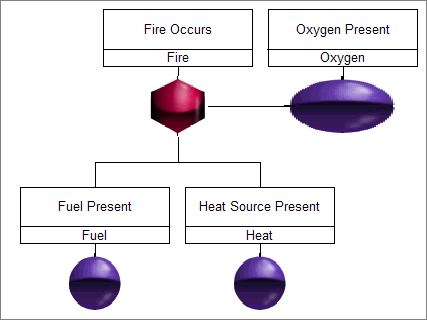Inhibit Gate
The inhibit gate is used to indicate that the output occurs when the input events (I1 and I2) occur and the input condition (C) is satisfied. An inhibit gate is very much like an AND gate with a condition. When you insert an inhibit gate in a fault tree, the conditional event is inserted along with it so that you can specify the input condition.

Summary of Logic:
If one input event is FALSE, the output is FALSE. If all input events and the input condition are TRUE, the output is TRUE.
A truth table for an inhibit gate follows. The Boolean equation for an inhibit gate is T = (I1, I2) * C.
I1 | I2 | C | Output |
|---|---|---|---|
T | T | T | T |
T | T | F | F |
T | F | T | F |
T | F | F | F |
F | T | T | F |
F | T | F | F |
F | F | T | F |
F | F | F | F |
Example
From the fire triangle, we know that there will be fire when fuel and a heat source are present, given the presence of oxygen. The two basic events and the conditional event are the three legs of the triangle. All three events must be TRUE for the top event, Fire, to occur.
